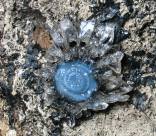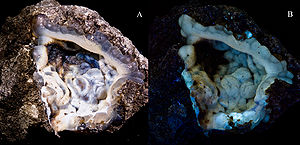Opal-CT
- Opal-CT
-
Lussatite
Lussatite (Opal-CT)
Catégorie III : oxydes et hydroxydes
|
Lussatite Mine des Rois, Puy-de-Dôme, France (18x13cm)
|
|
Général
|
| Catégorie |
Minéral |
| Formule brute |
SiO2*nH2O |
|
Identification
|
| Couleur |
blanche, grise, bleue |
| Échelle de Mohs |
5,5-6,5 |
| Éclat |
vitreux; résineux; nacré; cireux; gras; mat. |
|
Propriétés optiques
|
| Indice de réfraction |
no = 1,5442
ne = 1,5533 |
| Biréfringence |
Δ = 0,0091 ; biaxe positif |
| Dispersion |
2vz ~ 0-10° |
| Fluorescence ultraviolet |
oui |
| Trait |
blanc |
| Transparence |
Transparent, translucide, à opaque |
|
Autres propriétés
|
| Densité |
1.9-2,5 |
| Fusibilité |
Ne fond pas dans la flamme mais devient mate et crépite |
| Solubilité |
Soluble dans HF et KOH |
|
Caractères distinctifs
|
| Magnétisme |
aucun |
| Radioactivité |
aucune |
|
Principales variétés
|
La lussatite terme francophone qui désigne l'OPAL-CT (dénomination internationale de l'IMA) est une des quatre variétés d'opale. Composée de cristobalite-tridymite (d’où les deux lettre « C » et « T »).
Inventeur et étymologie
Décrite par le minéralogiste français François Ernest Mallard, le nom dérive du topotype.
Topotype
Lussat Auvergne, France.
Galerie
Lussatite (centre bleuté), auréolé de quartz, Auvergne France
|
Lussatite - Vue (7x7cm)- Mine des Rois, Puy-de-Dôme, Auvergne, France - A:Lumière du jour B: Ultraviolet
|
Gisements
En France
- Mine du Colombier des Roys, près de Dallet dans le Puy-de-Dôme. Ancienne mine d'Asphalte. [1]
- Lussat (Puy-de-Dôme)
- Coutras, Lot-et-Garonne, Aquitaine [2]
Dans le monde
- Steinbruch Katsch, Murau, Steiermark, Autriche.
- El Sol 3 (Encajon), Cajamarca, Province de Cajamarca, Pérou [3]
- Şaphane alunite, Pazarla, Province deKütahya, Région d'Aegean , Turquie[4]
- Creede Formation, Creede District, Mineral Co., Colorado, USA [5]
Références
- ↑ Aimé Rudel : "Curiosités Géologiques d'Auvergne et du Velay", Editions Volcans, 1970
- ↑ Econ Geol (1989) 84:1541-1556
- ↑ - Dill, H.G., Bosse, H.-R., Henning, K.-H., Fricke, A., and Ahrendt, H. (1997): Mineralogical and chemical variations in hypogene and supergene kaolin deposits in a mobile fold belt the Central Andes of northwestern Peru. Mineralium Deposita 32, 149-163.
- ↑ Mutlu, H., Sariiz, K., and Kadir, S. (2005): Geochemistry and origin of the Şaphane alunite deposit, Western Anatolia, Turkey. Ore Geology Reviews 26, 39-50.
- ↑ Minerals of Colorado (1997) E.B. Eckels
 Portail des minéraux et roches
Portail des minéraux et roches
Catégories : Silicate (minéral) | Tectosilicate
Wikimedia Foundation.
2010.
Contenu soumis à la licence CC-BY-SA. Source : Article Opal-CT de Wikipédia en français (auteurs)
Regardez d'autres dictionnaires:
Opal — Blaugrüne Opaladern in eisenreichem Muttergestein aus Australien Chemische Formel SiO2•nH2O Mineralklasse Oxide und Hydroxide 4.DA.10 (8. Auflage: IV/D.1 80) … Deutsch Wikipedia
OPAL — (von latein. opalus, vermutl. vom Sanskrit upala „kostbarer Stein“) bezeichnet: Opal, ein Mineral und Schmuckstein aus hydratisiertem Kieselgel Olaf Opal, deutscher Musikproduzent Opal (Band), eine US amerikanische Band der 80er Jahre ein feines… … Deutsch Wikipedia
OPAL — (Open Pool Australian Lightwater reactor) is a 20 megawatt pool type nuclear research reactor that was officially opened in April 2007 at the Australian Nuclear Science and Technology Organisation (ANSTO) Research Establishment at Lucas Heights… … Wikipedia
opal — OPÁL, opale, s.n. 1. Piatră semipreţioasă, cu luciu sticlos, incoloră sau variat colorată (verde, albastru, roşu, alb etc.), transparentă sau opalescentă. 2. Ţesătură de bumbac subţire şi străvezie, albă sau colorată în nuanţe deschise, din care… … Dicționar Român
Opal — 〈m. 1〉 1. 〈Min.〉 amorpher Quarz, wasserhaltiges Kieselsäuregel, ein Halbedelstein 2. 〈Textilw.〉 steif appretierter, milchähnlich durchscheinender, feinfädiger Baumwollbatist [<lat. opalus <sanskr. upala „Stein, oberer Mühlstein“] * * *… … Universal-Lexikon
Opal — Opal, Mineral, wasserhaltige Kieselsäure SiO2 mit wechselnden Mengen von H2O. Ohne Kristallform; nieren , traubenförmig, knollig oder unregelmäßige Hohlräume ausfüllend, auch erdig. Außerdem an Stelle früherer Lebewesen als deren… … Lexikon der gesamten Technik
Opal — O pal, n. [L. opalus: cf. Gr. ?, Skr. upala a rock, stone, precious stone: cf. F. opale.] (Min.) A mineral consisting, like quartz, of silica, but inferior to quartz in hardness and specific gravity. [1913 Webster] Note: The {precious opal}… … The Collaborative International Dictionary of English
Opal-AN — est la terminologie retenue pour désigner une variété d opale la HYALITE. La formule chimique est celle de l opale : SiO2nH2O. L étymologie de hyalite dérive du grec ancien ὕαλος, « qui a la transparence du verre ». L habitus est… … Wikipédia en Français
Opal — Sm ein milchigweißes Mineral per. Wortschatz fach. (17. Jh.) Entlehnung. Entlehnt aus l. opalus, dieses aus gr. opállios, aus ai. úpala Stein . Der Stein soll ursprünglich aus Indien gekommen sein. Opalglas ist nach der Farbe so benannt.… … Etymologisches Wörterbuch der deutschen sprache
Opal — Opal, WY U.S. town in Wyoming Population (2000): 102 Housing Units (2000): 48 Land area (2000): 0.430749 sq. miles (1.115636 sq. km) Water area (2000): 0.000000 sq. miles (0.000000 sq. km) Total area (2000): 0.430749 sq. miles (1.115636 sq. km)… … StarDict's U.S. Gazetteer Places
Opal, WY — U.S. town in Wyoming Population (2000): 102 Housing Units (2000): 48 Land area (2000): 0.430749 sq. miles (1.115636 sq. km) Water area (2000): 0.000000 sq. miles (0.000000 sq. km) Total area (2000): 0.430749 sq. miles (1.115636 sq. km) FIPS code … StarDict's U.S. Gazetteer Places



